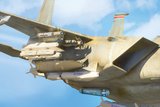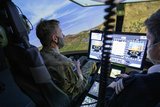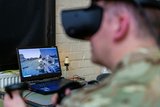How can the West exploit the disruptive technologies of the future? (Studio)
Brought to you in partnership with Viasat
The Five Eyes face an uncertain future. Although the partnership is traditionally an intelligence-gathering construct, the Five Eyes arrangement also plays a crucial role in connecting and supporting the militaries of its member nations.
Therefore, the evolving threats and technologies of modern warfare are a core focus for the states involved.
These technologies will define the future battlefield, from AI to 5G to cyber. As western countries look to a future of multi-domain operations (MDO), communications technologies will be critical, binding together different air, land, sea, space, and cyber assets.
These advances are taking place against a rapidly evolving military backdrop, defined by Russia’s invasion of Ukraine.
However, that military action has not evolved as Vladimir Putin may have anticipated.
Speaking before the US House of Representatives on 8 March, CIA Director William Burns said the invasion should remove any doubt about the depths of Putin’s determination.
‘[But] what he’s been met with since then, first and foremost by Ukrainians themselves in their courage and their heroism and the strength of their leadership, has surprised and unsettled him,’ Burns told the Permanent Select Committee on Intelligence.
Russia’s experiences highlight the importance of new technologies on today’s battlefield. That’s particularly true when it comes to communications.
Thomas Withington is an expert in radar, electronic warfare and military communications. He was ‘completely surprised by how badly Russian communications have appeared to perform’, having expected a much stronger performance.
‘In many ways, the [initial] invasion is probably the most dangerous part of the war for the Russians,’ Withington continued.
‘This is where it can really go wrong quickly. And if you can’t get that sorted at that stage, it does make you wonder where you can go, because communications do seem to be inadequate for what the Russians are trying to do.’
That raises questions over how Russia could modernise and overhaul its communications in the middle of a conflict, Withington noted, although he stressed it is still too early to predict the outcome.
Nonetheless, Moscow’s experience so far is a stark demonstration of the need for seamless battlefield connectivity. For the Five Eyes and the West more broadly, this is a vital element of the focus on MDO.
‘I think it does vindicate that [focus],’ said Withington. ‘I think it also underscores the serious importance of technological advantage … it underscores the need to make communications as secure as humanly possible.’
He pointed to the growing importance of technologies like millimetre wave communications and cognitive radio.
Of course, while the Russia-Ukraine war is a natural focus for western militaries, it’s one element of a broader landscape, which is impossible to predict. The nature of this environment will demand continued technological innovation.
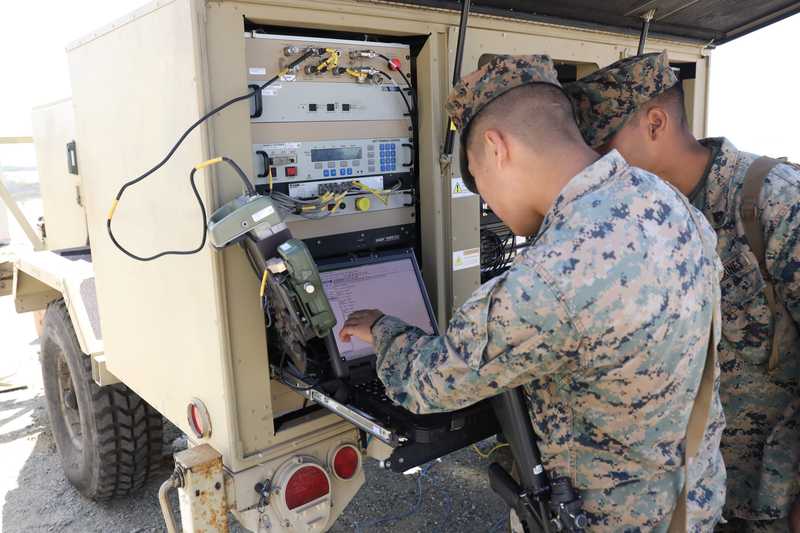
US Marines establish satellite communications during a combat readiness exercise
Dr Alexi Drew, a senior analyst at the RAND Corporation, notes that geopolitics have evolved over the decades, with new actors on the stage. There is also the potential for alternative alliances to emerge for those outside the club, such as between China and Russia.
The emergence of new agreements such as AUKUS ‘as a balance to other geopolitical concerns in that region of the world is only likely to increase the likelihood of seeing this rising competition against the alliance’, noted Dr Drew.
One peer rival looms above the rest, including even Russia. China has rapidly grown in economic and military strength, becoming a particular concern for the Five Eyes.
John Parachini, a senior international defence researcher at the RAND Corporation, notes that the ability of China to fund the expansion of its technology in developing countries – particularly in Africa – gives Beijing a real advantage.
However, this need not be an undue threat if the West competes.
‘US companies, Western companies, companies from the Five Eyes countries, have an opportunity here to compete, and we need to do that,’ said Parachini.
‘In order to get at that level to compete effectively with China, we’ve got to enter the game. And we’ve got to have technologies that are attractive at a price point that countries want to have.’
The Five Eyes operate in an increasingly complex and dynamic threat environment, in which their technological focuses must address not just nation-states, but a range of quasi-governmental and non-state actors.
There are often no fixed lines, noted Paul G. Buchanan, director of 36 Parallel Assessments, a geopolitical and strategic analysis consultancy.
‘We’ve entered into the era of hybrid warfare, where the overlap between kinetic operations and non-kinetic operations, between psychological operations and physical operations, is now increasingly blurred,’ he said.
Emerging technologies present both opportunities and threats. Cyberspace is a crucial example. Craig Miller, President of Government Systems at Viasat, points to the speed of change in this domain.
‘The things that [previously] only state-sponsored intelligence agencies could create, the things we call advanced persistent threats, you can buy them for $20 on the dark web today,’ Miller notes.
This creates a kind of arms race, he said, with western nations building defences that can handle these types of threats. On top of this, the adversaries are becoming more sophisticated at creating systems that make it difficult to attribute attacks.
‘It’s very easy for individuals and criminal organisations to do things that only intelligence agencies could do just a year or two ago.’
Cyberspace is just one focus of disruptive technologies in which the Five Eyes nations must take the lead in the years to come.
Against the backdrop of MDO, communications will have to evolve. Miller points to heterogeneous networks: the ability for users to operate more than one type of network using a multi-mode, multi-transport, software-defined approach. This could include everything from WGS to commercial networks like that offered by Viasat.
Some data might not be as crucial as other pieces of information, and could be sent over a commercial network. Other data might demand a hardened military network, such as nuclear C2.
‘The ability to decide in real-time – with automation – what data goes over what network at what time in what geography, that orchestration will be a key feature of multi-mode networks,’ Miller said.
Another key focus for modern communications is 5G. Part of its potential strength is the fact that it will soon be ubiquitous, while its beamforming abilities allow operators to point the signal in a particular direction, Miller explained.
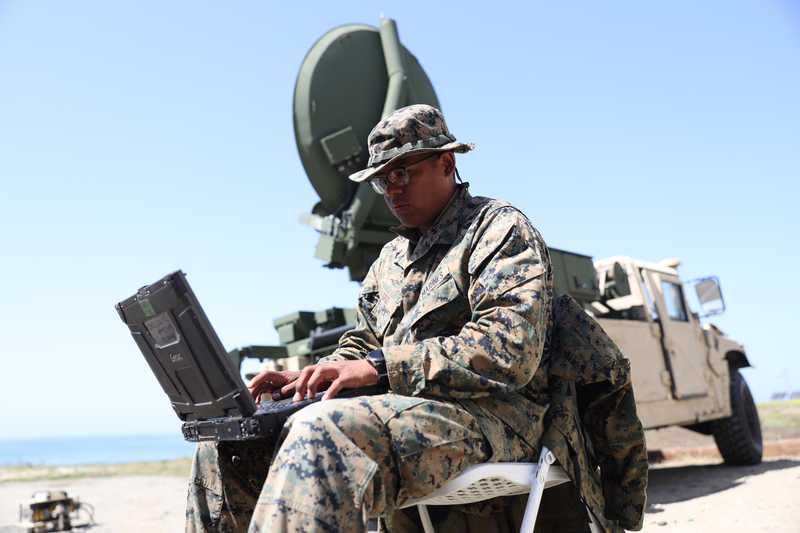
US Marine of Expeditionary Force Information Group, troubleshoots satellite communications during a combat evaluation
Satellite communications is another core focus. While this is not new, it is evolving through systems such as Viasat-3 and low earth orbit (LEO) constellations, often offered on a commercial basis.
‘You can have a 5G network and a resilient satcom network, but the key is bringing all those together and creating a new network that is essentially transparent to the user,’ Miller explained.
This network would then ‘orchestrate itself in machine time so that the user’s data moves over the right network at the right time in the right way’.
It will be crucial to build alliances with industry and tap into the defence industrial base’s sheer potential that western nations can access. This is certainly true for the intelligence community, the foundation of the Five Eyes.
‘The days where they had a monopoly over that technology are well and truly over,’ said Dr William Stoltz, senior adviser for public policy at the Australian National Security College, ‘And so partnerships with especially trusted entities in the private sector are essential now.’
What does the future hold? With rising peer rivals and continued threats from non-state actors, should we be pessimistic?
Or does the collaborative potential of the Five Eyes partnership provide a clear cause for hope?
For Miller, industrial advances could prove critical, particularly in the commercial domain.
Such companies often pioneer cutting-edge technologies today, in contrast to the situation some decades ago, when the military sector was dominant.
‘It’s also a way to close the spending gap,’ he added. ‘In the past, we were able to outspend [adversaries] sometimes by many orders of magnitude. That’s not going to be the case in the next 30 years – we’re going to be facing an economy that may be larger than ours.
‘And so the ability to leverage the trillions of dollars that are being spent in commercial research and development … that’s a way that you can still create that economic advantage.’
More from Studio
-
![Combat-proven capabilities: How precision-strike systems are evolving for tomorrow’s battlespace (podcast)]()
Combat-proven capabilities: How precision-strike systems are evolving for tomorrow’s battlespace (podcast)
Combat-tested technology is being reshaped to counter A2/AD threats, reduce reliance on GPS and enable faster, more autonomous targeting in complex environments. In this special podcast, experts explain how the evolving threat landscape is shaping next-generation strike capabilities.
-
![Energy evolution: How laser defence systems are powering the next phase of air defence (podcast)]()
Energy evolution: How laser defence systems are powering the next phase of air defence (podcast)
Laser-based air defence is moving from promise to deployment as global threats evolve. In this special podcast, we explore how high-energy laser systems are reshaping interception strategies.
-
![Intelligence advantage: How real-time GEOINT is reshaping military decision-making (Studio)]()
Intelligence advantage: How real-time GEOINT is reshaping military decision-making (Studio)
In today’s contested operational environment, adaptability is key. The new Geospatial-Intelligence as a Service (GEO IaaS) solution from Fujitsu and MAIAR empowers militaries by enabling intelligence advantage, combining advanced technology with human expertise to deliver actionable insights.
-
![Training Together: Unlocking Educational Excellence through Military and Industry Collaboration (Studio)]()
Training Together: Unlocking Educational Excellence through Military and Industry Collaboration (Studio)
Military training is ultimately about people. At Capita, training programmes are built on close engagement with partners, delivering an educational approach that can adapt to individual needs, cultivate leadership – and drive wider cultural change.
-
![Enhancing Military Training Through Digital Technology (Studio)]()
Enhancing Military Training Through Digital Technology (Studio)
Digital technologies offer huge opportunities for defence training. However, militaries must adopt an agile approach, placing the needs of their organisations and personnel at the centre of their efforts.
-
![Layered Defence: How new technologies are enhancing armoured vehicle survivability and manoeuvrability (Studio)]()
Layered Defence: How new technologies are enhancing armoured vehicle survivability and manoeuvrability (Studio)
As modern threats evolve, armoured fighting vehicles face a new era of challenges, from loitering munitions to kinetic energy projectiles. Advances in active, passive, and reactive protection systems are crucial to ensuring battlefield dominance, freedom of manouver and vehicle survivability.











